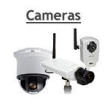|
Playback
The Playback windows allow you to review the recorded footage
for a camera. You can also perform some processing on the images to
improve the quality, and create independent videos for periods of
interest.
The top of the window consists of the tool bar. Taking these
buttons in order, they perform the following:
- The tools button toggles the display of the controls section
below the image.
- The next three buttons control the magnification of the image,
reducing the size, setting the size to default, and increasing the
size respectively. By default, these will zoom into the image, but
holding CTRL will cause the window size to be changed. This can
also be changed in the Look & Feel
settings.
- The next button is the audio button which is available if the
camera and recording supports audio and turns on and off the audio
from the recording.
- The next button is copy, which puts the current image on the
Windows clipboard from where it can be pasted into any suitable
application as a file or an image.
- The printer button simply prints the current image with its
date and time.
- The image enhancement button will toggle the display of two
sliders at the bottom the of window which will allow you to alter
the gamma correction and brightness of the image.
- The video/clapper board button will allow you to create an AVI
video from your recorded footage. Once opened, select the range of
images by finding the first image using the controls in the
Playback window, and pressing the 'Now' button to the right of the
'Start' box, then move to the last image and press the other 'Now'
button. The times can be adjusted manually and click clicking OK
when you're ready will ask you for a location to save the video and
a codec.
- The last button allows the current image to be added to the
gallery for archival purposes and for viewing later.
The area below the recorded footage contains a time line, a date
and time, a speed, 'video style' playback buttons and, on some
cameras, a loop play button.
- The time line is a graphical display of when movement has
occurred in the image over a 24 hour period. A red line indicates
there has been motion, and the height of that line indicates the
amount of motion in the period that line covers.
A full height green line shows a tripwire cross event allowing you
to see more important events easily. Clicking near a tripwire cross
will snap to that event but can be disabled by holding the Ctrl
key.
- The date and time allow you to select the day you wish to view,
and to jump to a particular time during that day. If there is no
image for the exact time you entered, the closest image to that
time will be displayed.
- The Speed slider allows you to change the speed at which the
footage is played back relative to real time speed, indicated with
with a marker underneath it.
- Some feeds (JPEG and Motion JPEG) have the ability to operate in loop play mode. When this is available, there will be another
button on the end of the playback controls. Pressing this button
will change the playback windows into 'Loop play' mode, disabling
the date selector buttons and instead the window will play, by
default, the last 5 images in a continuous loop. This number can be
altered in the 'Loop count' box. This mode can be useful to ensure
that any motion is not missed if you look away from the screen
briefly as the last motions will be replayed in the window.
- Some feeds will also have an option to show "Motion only" or
"All video". This allows you to skip periods when no motion has
occurred on feeds that use video stream recording to save direct to
disk.
Synchronised playback across several feeds
If you right click on a group in the feed tree or the `Local
console` item, there is a 'Synchronised playback' option which will
open a playback window showing all feeds in the group.
These can be controlled using the controls at the bottom as you
would normally with a single consolidated timeline.
Feeds can also be rearranged by dragging from one view to
another, and new feeds can be added by dragging the feed from the
Console tree or a folder from Explorer onto a view.
|

